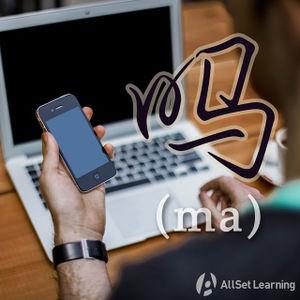Difference between revisions of "Questions with "le ma""
| Line 6: | Line 6: | ||
<div class="jiegou"> | <div class="jiegou"> | ||
| − | Subject + Verb + Object + 了吗 | + | Subject + Verb + Object + 了吗? |
</div> | </div> | ||
| − | + | == Examples == | |
<div class="liju"> | <div class="liju"> | ||
| Line 17: | Line 17: | ||
* 你 吃饭 <em>了 吗</em>?<span class="trans">Did you eat?</span> | * 你 吃饭 <em>了 吗</em>?<span class="trans">Did you eat?</span> | ||
* 你 看 <em>了 吗</em>?<span class="trans">Did you see?</span> | * 你 看 <em>了 吗</em>?<span class="trans">Did you see?</span> | ||
| + | * 他走 <em>了 吗</em>? | ||
| + | * 你 喝 酒 <em>了 吗</em>? | ||
| + | * 你 做 <em>了 吗</em>? | ||
| + | * 她 笑 <em>了 吗</em>? | ||
| + | * 你 给 我 打 电话 <em>了 吗</em>? | ||
| + | * 你 今天 喝 咖啡 <em>了 吗</em>? | ||
| + | * 你 吃 水果 <em>了 吗</em>? | ||
</div> | </div> | ||
| − | == | + | ==Structure with a Topic== |
<div class="jiegou"> | <div class="jiegou"> | ||
| − | + | Topic + (Subject) + Verb + 了吗? | |
</div> | </div> | ||
| − | + | note: in this structure, the topic is also the object for the Verb. | |
| + | |||
| + | == Examples == | ||
<div class="liju"> | <div class="liju"> | ||
| − | * 北京 去 <em>了 吗</em>?<span class="trans">Did you go to Beijing?</span> | + | * 北京 你 去 <em>了 吗</em>?<span class="trans">Did you go to Beijing?</span> |
| − | * | + | * 晚饭 你 吃 <em>了 吗</em>?<span class="trans">Did you eat a dinner?</span> |
| − | * 电影 看 <em>了 吗</em>?<span class="trans">Did you see the movie?</span> | + | * 电影 你 看 <em>了 吗</em>?<span class="trans">Did you see the movie?</span> |
| + | * 作业 你 写 <em>了 吗</em>? | ||
| + | * 这 本 书 你 读 <em>了 吗</em>? | ||
| + | * 衣服 你 买 <em>了 吗</em>? | ||
| + | * 酒 你 喝 <em>了 吗</em>? | ||
| + | * 电话 你 给 我 打 <em>了 吗</em>? | ||
| + | * 咖啡 你 今天 喝 <em>了 吗</em>? | ||
| + | * 水果 你 吃 <em>了 吗</em>? | ||
</div> | </div> | ||
| Line 58: | Line 74: | ||
[[Category:A2 grammar points]] | [[Category:A2 grammar points]] | ||
| − | {{Basic Grammar|了|A2|V + 了 + 吗?| | + | {{Basic Grammar|了|A2|V + 了 + 吗?|你 去 <em>了 吗</em>?|grammar point|ASGYKDNF}} |
{{Rel char|吗}} | {{Rel char|吗}} | ||
{{Similar|Yes - no questions with ma}} | {{Similar|Yes - no questions with ma}} | ||
Revision as of 05:54, 29 October 2013
-
Level
-
Similar to
-
Used for
-
Keywords
Asking questions about completed actions will involve using both 了 and 吗. These are simply added to the end of a sentence or statement. This means you might see questions with 了 and 吗 in different structures.
Contents
General structure
Subject + Verb + Object + 了吗?
Examples
- 你 去 了 吗?Did you go?
- 你 吃饭 了 吗?Did you eat?
- 你 看 了 吗?Did you see?
- 他走 了 吗?
- 你 喝 酒 了 吗?
- 你 做 了 吗?
- 她 笑 了 吗?
- 你 给 我 打 电话 了 吗?
- 你 今天 喝 咖啡 了 吗?
- 你 吃 水果 了 吗?
Structure with a Topic
Topic + (Subject) + Verb + 了吗?
note: in this structure, the topic is also the object for the Verb.
Examples
- 北京 你 去 了 吗?Did you go to Beijing?
- 晚饭 你 吃 了 吗?Did you eat a dinner?
- 电影 你 看 了 吗?Did you see the movie?
- 作业 你 写 了 吗?
- 这 本 书 你 读 了 吗?
- 衣服 你 买 了 吗?
- 酒 你 喝 了 吗?
- 电话 你 给 我 打 了 吗?
- 咖啡 你 今天 喝 了 吗?
- 水果 你 吃 了 吗?
Notice that in these examples the object is introduced first as a topic.
Finally, please notice that this pattern is nothing more than the combination of the Expressing completion with le pattern and the Yes - no questions with ma pattern.
See also



